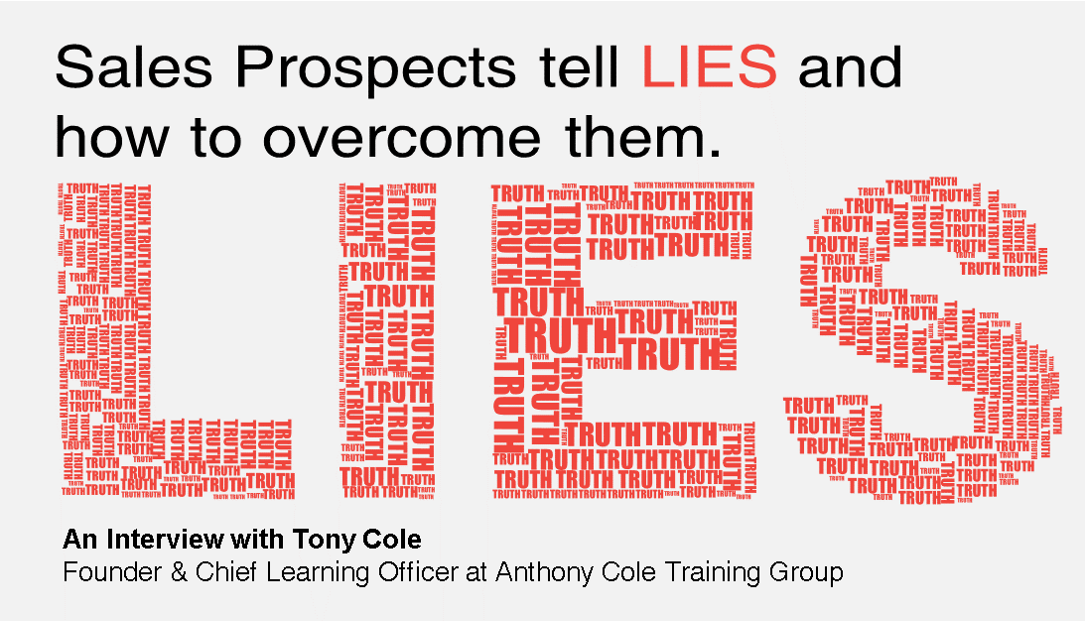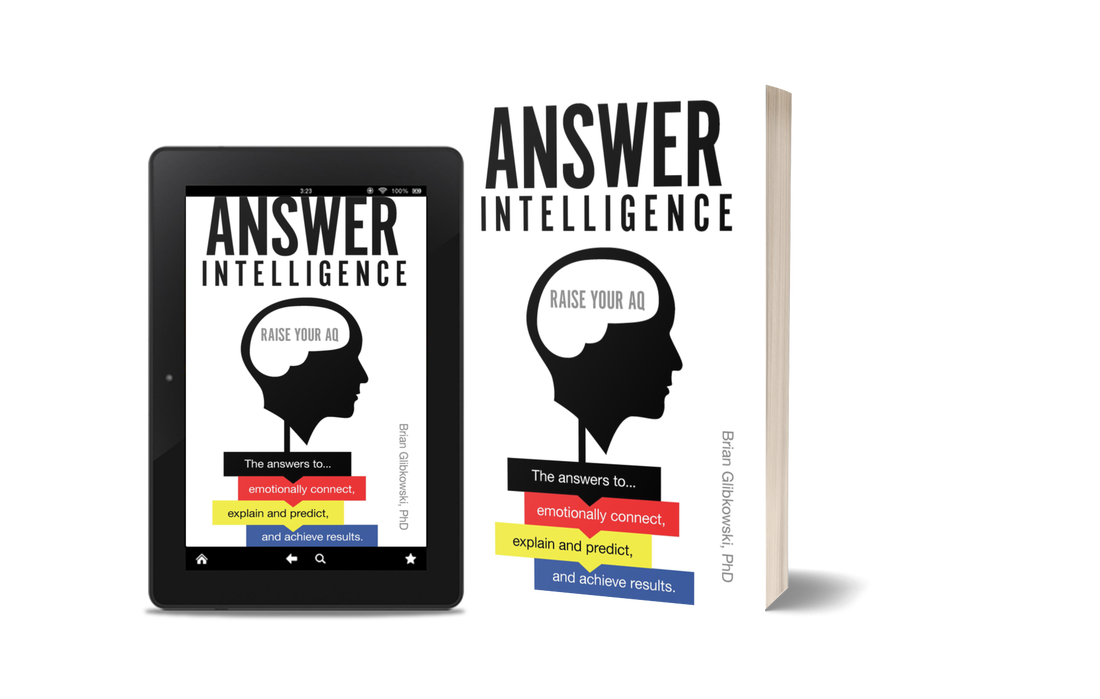|
Tony Cole is the Founder & Chief Learning Officer at Anthony Cole Training Group, LLC. For 27 years, Anthony Cole Training Group has been helping organizations close their sales opportunity gap by helping them sell better, coach better, and hire better. This article is part of the High AQ Interview Series where executives, academics, and thought leaders discuss elevated answers. The following interview is edited for clarity. All prospects Lie and/or lieThere is a Lie with an upper-case-L that is barefaced and hurtful. Then there is a lie with a lower-case-l, a lie that is not hurtful, hateful, or deceitful. We associate the AQ answers (story, metaphor, theory, concept, procedure, action) with the lies (upper + lower case) or truth prospects communicate. A sales rep can ask, “Why did you agree to this meeting?” The prospect may return with a white lie (withholding a house-on-fire story), or not acknowledging a vendor off-stage (perhaps a capital-L lie). Of course, lies exist on a continuum between upper-case and lower-case lies. The following discussion centers upon lies during conversations with prospects and how Answer Intelligence (AQ)™ can help separate the lies from the truth. Dr G: “There are a lot of question methodologies in sales. How does AQ add value?” Tony Cole: “I just conducted a three-hour workshop on the art and science of question asking. We teach about the importance of effective questions to get the answers you want, but it is great to have a simple visual of questions and answers that can orient a sales rep for their next important conversation.” Dr G: “Can you give me a specific example of how the AQ framework can help sales reps?” Tony Cole: “We teach about the importance to know that prospects lie (not hurtful, hateful, or deceitful). The prospect will provide an answer to meet their objectives as a buyer. You must understand the motivation of the buyer. When a prospect agrees to a meeting, it might be because the prospect has a new boss and was asked to investigate the seller’s solution. The prospect’s intention may not be to buy, but to interpret the seller’s solution using a hidden compare-and-contrast to a favored solution. Ultimately, although possible to overcome, the outcome on the scales is tipped toward a no. The prospect ultimately wanted to report back to her boss that she checked out the solution, and her alternative was better. In this scenario, AQ is valuable because it connects questions to answers so a seller knows which types of answers to expect and how to navigate those answers. For example, we teach drill-down questions. Therefore, we could drill-down into a story or procedure [both answers in AQ terms] to get at the truth.” Dr G: “This is interesting. It reminds me of the 5-Whys associated with Japanese management approaches. You ask Why five times and by the 5th time (or sooner), you get to the root cause. Therefore, in AQ terms, if a story is provided by a prospect, a seller can ask Why multiple times to understand it. In similar terms, if a metaphor answer is provided a seller can ask What multiple times; or a for a procedure answer that is provided a seller can ask How multiple times.” Tony Cole: “It is important to note that the drill-down can’t be mechanical. You correctly point out, you may stop after 2 drill downs, but a sales rep that is acting mechanical would always ask 5 drill down questions. Or, if a seller is provided questions to ask, too often they go through the list of questions in a check list style manner…. What is keeping you up at night? Why did you contact me? What is your budget?... Question fatigue will set in. This is an example of what we mean by the art of question asking.” Dr G: “Interesting. Your drill-down questions remind me of the Five High AQ practices and techniques that can be used to gauge the veracity of answers. For example, High AQ practice 3 is to provide complements. Every given answer can be complemented by adjacent answers. For example, if a prospect tells a story, a seller can ask a follow up question, “Can you explain the underlying logic of your story?” this would represent a theory answer (in AQ terms). Or as a seller can paraphrase the buyer’s story as a metaphor. Both theory and metaphor are adjacent answers, and they help you triangulate the truth of the seller’s answers. Or you can pivot to any answer type. At the extreme, if all six answer types (story, metaphor, theory, concept, procedure, action) are covered, which is referred to as the strong form of complementary answers, then you have a complete sense of their true answers. Lies or half-truths are difficult to maintain across multiple answer types, and naturally give way to true answers as you begin to triangulate all the answers together.” Tony Cole: “This makes sense. Also, the AQ framework can be connected to open vs. closed questions. We discourage closed questions that yield yes, no answers; these are conversation killers. The six AQ answers are associated with open questions, where you would anticipate a story, metaphor, or any of the six answer types.” Tony Cole: “What type of answer should a seller be looking for from a prospect?” Dr G: “Great question. The AQ framework suggests there are 5 High AQ practices, and each practice suggests a different answer type(s) to focus upon. For example, High AQ Practice 1 focuses upon identifying the best answer to a given question. Therefore, if a seller asks, “Why did you take my meeting?” the seller may be interested in a story or a theory as the best answer. Perhaps, the seller wants a story and its associated richness to start the conversation. High AQ Practice 3, as discussed prior relates to providing complementary answers. In that case, if a story answer is provided by the seller, the buyer would be looking to steer the conversation toward a theory and/or metaphor answer. Finally, one more example, according to High AQ Practice 4, Answer with Style, a seller would try to identify the answer style of a buyer—relational (preference for story + metaphor), analytical (preference for concept + theory), or practical (procedure + action)—and try to steer the conversation toward the preferred answer preferences of the buyer. Each of the 5 High AQ answers provides a partially overlapping approach toward identifying the target answer types of a buyer. Related to your prior point, choose which one of the 5 High AQ practices to focus upon at each point in the conversation, and over the entire conversation, get into the art of communication.” Tony Cole: “There is a place for this. The whole idea… of asking questions in and of itself is a challenge. AQ makes it easier, when you ask a question, only some categories of answers are possible. The two things, questions and answers, come together in one framework with AQ.” This article suggests at least one High AQ takeaway. High AQ Takeaway: Seller conversations often involve white lies or unfortunately barefaced lies. Using AQ and the 5 High AQ practices, it is possible for the seller to steer the conversation toward the truth, saving everyone time, building relationships, shortening sales cycles, closing more deals, and perhaps first and foremost just making conversations with prospects more enjoyable. If you found Answer Intelligence (AQ)™ an interesting framework, please share this post with others.
Try our Sales AQ free test to gauge your AQ.
0 Comments
Leave a Reply. |
Access Octomono Masonry Settings
AuthorDr. Brian Glibkowski is the author of Answer Intelligence: Raise your AQ. Archives
October 2022
Categories
All
|
About AQ
Answer Intelligence (AQ)™ is the ability to provide elevated answers to explain and predict in a complex world, emotionally connect, and achieve results. Are you conversation ready?
Meet HarperHarper's story illustrates the transformative power of AQ in her own career and in the success of her organization.
|
AQ Upskilling PlatformAI is machine thinking. AQ is human thinking (developed based on academic research) in terms of simple questions (why, what, how, when, where, who) and answers (concept, metaphor, theory, story, procedure, action) that elevate human-to-AI and human-to-human communication.
|
Quick Access LinksBuy the Book
Explore AQ (Free Assessment) AQ TEDx Video Professional Services Firms + AQ Brian Glibkowski, PhD - AQ Creator Meet Harper - Overview Video Meet Mark - Software Case Reasons You Need AQ |
Featured |




 RSS Feed
RSS Feed